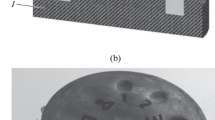Abstract
Shock-induced chemical synthesis and synthesis-assisted consolidation of high-temperature materials (suicides) were investigated. Niobium, molybdenum, and titanium powders mixed with silicon powders were chosen as reactant materials for shock-induced synthesis of silicides. In parallel experiments, these reactant materials were also respectively mixed with inert intermetallic compound powders of NbSi2, MoSi2, and Ti5Si3 in different proportions and were shock consolidated. Shock processing was carried out using a modification of the experimental set-up developed by Sawaoka and Akashi. The shock waves were generated in the materials by the impact of a flyer plate at a velocity of 2 km sec−1. An explosive plane-wave generator was used to initiate the main explosive charge to accelerate the flyer plate. The passage of shock waves of sufficient pressure and temperature induced a highly exothermic and self-sustaining reaction between reactant materials. The shock-synthesized intermetallic compounds and the heat of reaction enhanced bonding between inert matrix materials. The proportion of reactant powder mixtures blended with inert intermetallic materials plays a very important role in the synthesis-assisted consolidation process. Characterization of compacts was done by optical microscopy, scanning electron microscopy, and X-ray diffraction. A preliminary analysis of shock-induced chemical reactions is conducted; it predicts a 30% increase in shock pressure and shock-wave velocity over those in unreacted powders. For shock synthesis, the profuse formation of voids indicates that melting of the material occurred; in contrast, unreacted regions did not exhibit porosity.
Similar content being viewed by others
References
J. H. Westbrook,Metall. Trans.8A (1977) 1327.
H. A. Lipsitt, D. Shechtman, andR. E. Schafrik,ibid.6A (1975) 1991.
D. Shechtman, M. J. Blackburn andH. A. Lipsitt,ibid.5A (1974) 1373.
Z. A. Munir,Ceram. Bull.67 (1988) 342.
P. S. DeCarli, US Patent 3238019 March, (1966).
P. S. DeCarli andJ. C. Jamieson,133 (1961) 821.
S. S. Batsanov, A. A. Deribas, E. V. Dulepov, M. G. Ermakov andV. M. Kudinov,Comb. Expl. Shock Waves USSR1 (1965) 47.
A. N. Dremin andO. N. Breusov,Russ. Chem. Rev.37 (1968) 392.
R. A. Graham, B. Morosin, E. L. Venturini andM. J. Carr,Ann. Rev. Mater. sci.16 (1986) 315.
Y. Kimura,Jpn. J. Appl. Phys. 2 (1963) 312.
Y. Horie, R. A. Graham andI. K. Simonsen,Mater. Lett.3 (1985) 354.
I. K. Simonsen, Y. Horie, R. A. Graham andM. J. Carr,ibid.5 (1987) 75.
A. B. Sawaoka andT. Akashi, US Patent 4655830 (1987).
T. B. Massalski “Binary Alloy Phase Diagrams” (American Society for Metals, Metals Park, Ohio, 1986).
F. R. Norwood, R. A. Graham andA. Sawaoka, in “Shock Waves in Condensed Matter”, edited by Y. M. Gupta (Plenum, New York, 1986) p. 837.
Y. Horie andM. J. Kipp,J. Appl. Phys.63 (1988) 5718.
M. Yoshida, Mixture Program, Report, Center for Explosives Technology Research, New Mexico Institute of Mining and Technology, Socorro, New Mexico, 1986.
L. V. Altshuler,Sov. Phys.8 (1965) 52.
M. A. Meyers andS. L. Wang,Acta Metall36 (1988) 925.
O. Kubaschewski andC. B. Alcock, “Metallurgical Thermochemistry” (Pergamon, New York, 1979).
Author information
Authors and Affiliations
Rights and permissions
About this article
Cite this article
Yu, L.H., Meyers, M.A. Shock synthesis and synthesis-assisted shock consolidation of suicides. J Mater Sci 26, 601–611 (1991). https://doi.org/10.1007/BF00588294
Received:
Accepted:
Issue Date:
DOI: https://doi.org/10.1007/BF00588294




